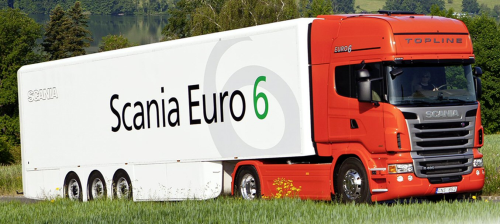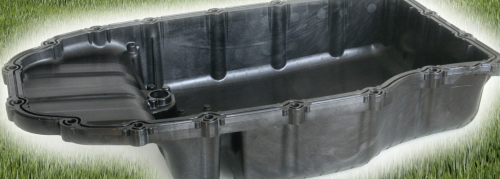

The lightweight yet robust oil sump is the lower shell of the oil pan module. It was produced in Sweden by the Plastal Group AB, with material, design and processing support from DuPont and the input of prototype specialist Idé-Pro of Skive, Denmark.
The oil sump is moulded from a heat-stabilised, 35% glass fibre reinforced grade of Zytel polyamide (PA) 66, which is suitable for harsh, under-the-hood applications involving high temperatures and oil. Its low melt viscosity means it readily fills thin section moulds, which, in combination with fast set up times, contributes to very fast moulding cycles.
According to the development team at Scania, their main reasons for choosing Zytel were that it meets technical requirements when used in oxidised oil and still provides the necessary level of impact performance.
The adoption of the DuPont thermoplastic material for this application is a first for the truck market, and only the second development for commercial production vehicles worldwide following the launch of the Daimler oil pan module in 2008. It has enabled a reduction in the weight of the component by over 50%, or 6 kg, versus its aluminium predecessor to improve fuel economy and reduce emissions.
Scania also found that switching from metal to plastic in the oil sump dampens engine noise to help meet Euro 6 noise emission standards.
Part development
Having settled on the initial design and material, Scania contacted Idé-Pro to undertake the first steps in the part's development.
"Scania contacted us for our help in producing the first prototypes of a new oil sump made of thermoplastics," says Morten Frandsen, Idé-Pro. "The challenge was to produce an injection moulding tool, avoiding warpage in the large plastic part."
"Our skilled tool designers used advanced Moldflow analysis. That way we actually produced an oblique tool which resulted in a perfectly straight oil sump."
Beyond material selection, DuPont also assisted Scania in refining the sump's design and the production process, particularly with regard to achieving a consistently tight seal between the sump and the engine. This required very precise tolerance control of a large component, measuring 847 mm (length) x 467 mm (width) x 203 mm (height), achieved by comprehensive mould flow analyses, prototype testing and ongoing optimisation of processing parameters.
“Ribbing on the underside of the sump also plays a key role in remaining within the permitted tolerances for the part, as well as performing a secondary function as a defensive shield against stone impacts,” reports Murray Smith, development specialist at DuPont Performance Polymers in Sweden.
Its effectiveness in this role was tested at DuPont's European Technical Centre in Geneva, where a high-speed impact compressed air cannon was used to fire steel balls at an angle of 45° and at a speed of 80 kph (50 mph) at the sump. These tests confirmed that the ribs effectively dissipate the impact energy, becoming damaged in the process, whilst the structural integrity of the sump remains preserved.
Scania Euro 6 engine
Scania unveiled the new 440 and 480 hp (324 and 353 kW) 13-litre Euro 6-compliant engines in 2011.
Learn more about the Scania Euro 6 engine in this video.


